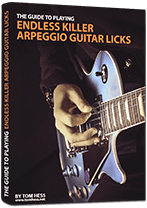Phrygian Dominant Lead Guitar Licks Lesson

EMAIL TO GET ACCESS
By submitting your info, you agree to send it to Tom Hess Music Corporation who will process and use it according to their privacy policy.
Do you like Yngwie’s lead guitar playing?
If so, you’re in luck.
Because in this neoclassical shred guitar article...
I’ll show you awesome guitar licks using one of Yngwie’s signature neoclassical shred guitar scales:
The Phrygian dominant guitar scale.
Aka: the 5th mode of harmonic minor.
And even though this lead guitar scale has the same notes as the plain-old harmonic minor…
… the Phrygian dominant scale makes your neoclassical shred guitar licks sound way more aggressive and powerful.

EMAIL TO GET ACCESS
By submitting your info, you agree to send it to Tom Hess Music Corporation who will process and use it according to their privacy policy.
Today...
I’ll teach you the Phrygian dominant scale and show you simple neoclassical guitar licks you can play in your next shred lead guitar solo.
Ready to start?
Great!
To begin, watch this harmonic minor lead guitar video that explains the ins & outs of the Phrygian dominant scale:
Now that you know what the Phrygian dominant scale and how it relates to the harmonic minor scale…
… here are 5 more neoclassical shred guitar tips that help you to not only master the Phrygian dominant guitar scale, but also use it to play better lead guitar licks and solos.
Neoclassical Shred Lead Guitar Tip #1: Learn The 7 Shapes Of The Phrygian Dominant Scale All Over The Guitar.
Even though the Phrygian dominant guitar scale is the 5th mode of harmonic minor…
… this doesn't mean you only play it in one position on guitar.
This guitar scale has 7 notes, so there are 7 positions to learn. These 7 guitar scale shapes snap together like pieces of a jigsaw puzzle – mapping out the entire fretboard. And once you memorize all 7 shapes of the Phrygian dominant guitar scale, you’ll eventually stop thinking of “isolated scale shapes” when you play guitar. You’ll start seeing the entire guitar fretboard as ONE integrated scale shape.
When this happens, you become musically free (to play awesome neoclassical shred guitar licks and lead guitar solos) in ways most guitar players in the world will never be.
Watch this video to see how to best memorize lead guitar scale shapes:Question: “But Tom Hess, if there are 7 shapes of this guitar scale, how is the sound of the Phrygian dominant different from any other mode of the harmonic minor guitar scale?”
Answer: That’s because the sound of each mode comes from the chords you play – not the guitar scale shapes you use in your lead guitar licks and solos.
When you have a chord progression in the key of Phrygian dominant (for example: chords E7 D E7 F E7 in the key of E Phrygian dominant/5th mode of A harmonic minor) – any of the 7 positions of the A minor harmonic minor scale will create the Phrygian dominant feel in your neoclassical shred guitar licks.
Question: “What if I already have a lot of things to practice (including other guitar scales to memorize)? How can I fit in memorizing harmonic minor guitar scale shapes?”
Answer: Here are 2 simple ways to memorize guitar scale shapes without adding a lot of guitar practice time:
1. Memorize guitar scale shapes away from the guitar. For example: when you drive your car (and are standing at a traffic light – waiting for it to turn green), put your fretting hand on your picking hand’s forearm (pretending it’s a fretboard). Go through the motions of any guitar scale shape you want to memorize.
Do this many times during the day (a few seconds here and there) and you will memorize harmonic minor scale shapes very quickly.
2. Set a timer on your phone to go off every hour and spend 2-3 minutes practicing the guitar scale patterns you are trying to memorize. Then go back to doing whatever you were doing before.
This helps you memorize lead guitar scale shapes a lot faster (compared to waiting for 1 big chunk of practice time to work on this skill).
Question: “Tom Hess, should I practice these harmonic minor scale patterns using a metronome?”
Answer: It depends. When you are first learning the Phrygian dominant guitar scale patterns and all your attention is devoted to moving your fingers correctly – don't use a metronome. It would just be a distraction from developing your lead guitar technique and muscle memory.
But once you can play the harmonic minor guitar scale patterns without thinking? Then it’s time to test yourself with the metronome to see just how fast you can play the guitar scale shapes cleanly.

Neoclassical Shred Lead Guitar Tip #2: Use The Phrygian Dominant Scale In Blues Guitar Solos
Yes, you read correctly. I said to use a variant of the harmonic minor guitar scale (the scale most often used to play neoclassical shred guitar licks) to play BLUES.
How to do this?
Simple. Treat each of the 12-bar blues chords as a new Phrygian dominant key. For example: take the chords of 12-bar blues in A: A7 D7 E7.
 Improve Sweep Picking Accuracy
Improve Sweep Picking AccuracyFind out how to play clean sweep picking arpeggios for lead guitar.
 Play Fast Sweep Picking Arpeggios
Play Fast Sweep Picking ArpeggiosPlay lightning fast arpeggios using
a sweep picking rolling technique.
 How To Fix Unclean Guitar Playing
How To Fix Unclean Guitar PlayingFix sloppy playing by reading this article about muting string noise.
We can treat these 3 chords as 3 Phrygian dominant keys, like this:
The A7 chord implies the 5th mode of D harmonic minor. The D7 chord implies the 5th mode of G harmonic minor. And the E7 chord implies the 5th mode of A harmonic minor.
Knowing this, you can easily play neoclassical shred guitar licks using the correct harmonic minor guitar scale fingerings.
That said, since each chord rings out for a long time, it creates 2 unique lead guitar soloing challenges.
For one thing: it’s rather tricky to solo over the same chord without repeating the same neoclassical shred guitar licks over and over again. (That said, neoclassical shred guitar masters like Yngwie Malmsteen are great at this skill.)
The other challenge is: quickly changing keys from one set of guitar scale shapes to another. That said, both lead guitar challenges can be easily overcome with practice (especially if you take guitar lessons).
Question: “But Tom Hess, this kind of lead guitar soloing won’t sound bluesy at all!”
Answer: Correct – but that’s not the point. Of course, using neoclassical shred guitar licks over a blues progression won’t sound bluesy. But this kind of lead guitar soloing can still sound great in its own right (especially if you have excellent lead guitar phrasing).
And besides, we are working on your neoclassical shred lead guitar playing here, no? :)
That said, you can also use guitar licks that are ‘typically’ associated with neoclassical shred playing *without* sacrificing the blues sound of your lead guitar solos.
Like this:
Neoclassical Shred Lead Guitar Tip #3: Use The Pentatonic Version Of The Phrygian Dominant Guitar Scale.
If you take the fingering of the 5th mode of harmonic minor guitar scale and remove notes 3 and b7, you end up with a “pentatonic” version of the Phrygian dominant.
That guitar scale is officially known as the Hirajoshi scale.
And if you want your neoclassical shred guitar licks to stand out from other lead guitar players…
You’ve got to know (and use) the Hirajoshi scale.
Since it only has 5 notes, the Hirajoshi scale only has 5 box shapes. But they all snap together to cover the fretboard, exactly as the 7 shapes of the harmonic minor scale.
When you create guitar licks from this “pentatonic version” of the 5th mode of Harmonic minor, your lead guitar playing sounds very exotic.
Watch this video to learn more about the Hirajoshi scale (and how you can use it to make your neoclassical shred lead guitar licks more creative):
My favorite example of a guitar player who uses the Hirajoshi scale (along with harmonic minor guitar scales) is Marty Friedman.
His famous solo “Tornado Of Souls” (by Megadeth) is a great example of Hirajoshi scale in action.
Neoclassical Shred Lead Guitar Tip #4: Integrate Harmonic Minor Guitar Scale Patterns With Other Licks And Lead Guitar Techniques.
Like it or not, simply knowing the Phrygian dominant scale and the harmonic minor scale shapes isn’t enough to play neoclassical shred guitar licks.
Why? Because neoclassical shred guitar players (like, say, Yngwie Malmsteen) combine many guitar techniques in their guitar licks.
So, one of the skills you’d better practice is integration of various guitar techniques together.
The most obvious guitar techniques to integrate are guitar scales and arpeggio patterns.
Watch this video to see an example of practicing lead guitar integration:
As you practice integration of neoclassical shred guitar techniques, focus on the ‘transition fragment’ between the techniques you are connecting.
For example: if you are connecting a harmonic minor guitar scale shape with a 2-hand tapping lick, the ‘transition fragment’ is the final 1-2 notes of the harmonic minor scale shape and first 1-2 notes of the 2-hand tapping lick.
As you play the lead guitar transition fragment, pay extra attention to:
- keeping the notes in time. Make sure the notes are not rushed (and there is no hesitation as you move from one part of your lead guitar lick to the next).
- string noise control. Use thumb muting on the lower in pitch strings (rest your picking hand’s thumb on the thicker strings to keep them from ringing out). And use your fretting hand’s index finger to mute the higher in pitch strings.
- articulation –you should be able to hear every note of the fragment clearly.
Neoclassical Shred Lead Guitar Tip #5: Work On Your 2-Hand Synchronization As You Play Phrygian Dominant Scale Patterns.
Most guitar players who want to play neoclassical shred guitar licks and solos sacrifice their 2-hand synchronization for maximum speed.
This is a mistake.
Because without 2-hand synchronization, your Phrygian dominant neoclassical shredding simply won’t sound good.
Here are some of the best ways to get your hands to be in sync as you are working on memorizing harmonic minor guitar scale shapes and refining your neoclassical shred chops:

Of this list, my favorite 2-hand synchronization drill is practicing unplugged.
Why? Because it’s very simple to do and you feel the positive effects of it in your lead guitar technique almost immediately.
Simply spend 5-10 minutes per day practicing your guitar licks (such as your harmonic minor guitar scale shapes) without an amp.
After you do, your regular lead guitar playing (with the amp on) will sound and feel much easier, cleanser and faster.
Question: “But Tom Hess, when I practice unplugged, I can’t play nearly as fast as I can with distortion. What should I do?”
Answer: This is normal. When you practice unplugged (whether you are working on neoclassical shred guitar playing or anything else), you need to use more picking hand power to produce clear notes. This forces you to play slower. However, it also makes your picking hand stronger. And that means: when you turn on distortion, you will likely play faster.
On top of this, playing your neoclassical shred guitar licks unplugged forces you to focus on hand independence. What’s hand independence? It’s the ability for one hand to stay relaxed while the other hand is using a lot of (necessary) tension.
When you play unplugged, hand independence is very hard to control. But as this skill improves, you’ll have a much easier time keeping your hand in sync and playing fast lead guitar licks.
You now know one of the coolest guitar scales to use for neoclassical shred lead guitar playing. But when it comes to developing the guitar speed you need for harmonic minor shred guitar licks…
… one problem guitar players have is using way ‘too much’ muscle tension.
And using too much tension kills guitar speed.
There are 9 types of tension guitar players typically suffer from. Most have at least 6 types, but are aware of only 1-2. That’s why they are stuck. I can help you identify and remove excess muscle tension from your playing in my free online training mater class called: “Total Guitar Playing Tension Control.” Watch it today to say goodbye to tension and experience a lifetime of bigger, better, faster and easier guitar gains.Enter Your Name And Email Address To Watch The Class:
By submitting your info, you agree to send it to Tom Hess Music Corporation who will process and use it according to their privacy policy.

Ready to level-up your guitar playing? Learn how with the best online lessons for guitarists.

